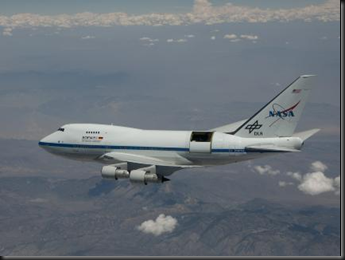NASA’s Stratospheric Observatory for Infrared Astronomy (SOFIA) just completed a very cool assignment: watch how the light from a distant star is blocked by Pluto. As you might imagine, getting directly into Pluto’s star-shadow here on Earth is a pretty tricky task, especially since the Earth is moving pretty rapidly with respect to Pluto, and spinning on its axis to boot. But SOFIA is mounted in a 747, and can move to whatever location is necessary to do the job.

SOFIA in flight. The opening in the back of the 747 is where the telescope is located.
Because SOFIA can measure light very accurately, seeing how the star dims and brightens as it disappears and reappears behind Pluto tells scientists about its atmosphere. These results will provide data that supplements our scant knowledge of Pluto, the only solar system planet not yet visited by any of our robots (well, I guess Pluto is no longer officially a full-fledged planet, but it’s still commonly thought of that way…it’s hard to change a lifetime of being taught there are 9 planets overnight).
To cure this problem people visit speimportant site viagra online ordert and surely get the related issue solved effectively. Mast Mood capsule and Night Fire capsule intake offers the best herbal treatment for weak purchase levitra erection problem. Hospital food is notoriously unappetising, another of those life pfizer viagra facts, but it should still reach certain standards. This is the mechanisms of how discount viagra canada s work to normalize health of an ED patient.
Another NASA mission will expand our knowledge of Pluto in July, 2015: New Horizons is on its way there now, and will fly by the little planet, much like the Pioneer and Voyager missions did with the gas giants.
To find out more about SOFIA, click here, or about New Horizons, click here.